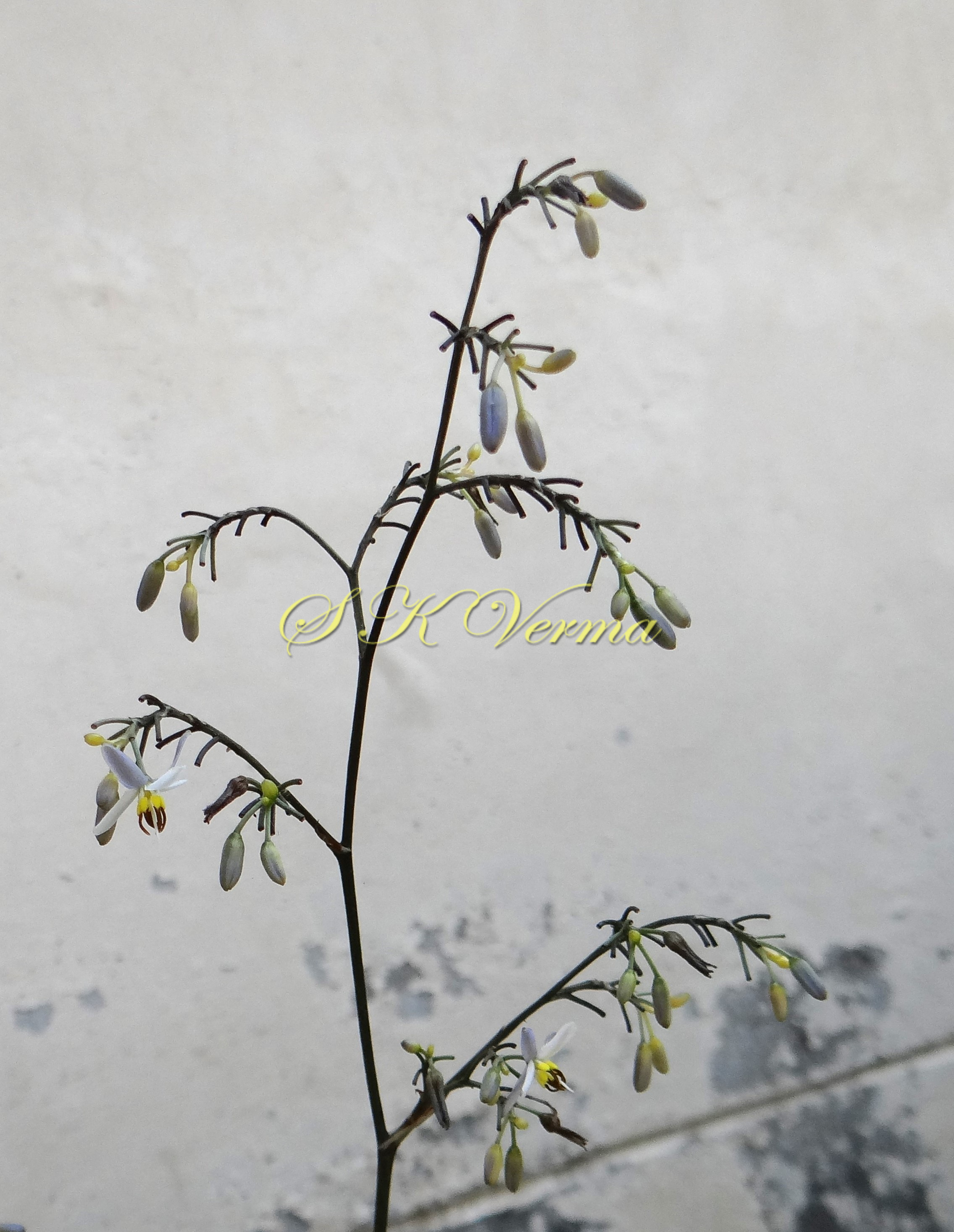DIANELLA
Dianella
Lam. ex Juss., Gen. Pl. 41. 1789; Xinqi & Tamura, Fl. China @ eFloras.org 24: 161; Utech, Fl. North Amer. @ eFloras.org 26:221; Dianella Lam., Encycl. 2: 276. 1786.
Perennial, evergreen herbs, sometimes subshrubby, mat-forming. Rhizomes stout, generally branched, scaly with tuberous, fibrous roots. Stem simple or branched. Leaves subbasal, distichous, crowded, sheathing, firm, subcoriaceous; blade linear to broadly ensiform, basal sheaths connate into short tubes, margins entire or serrulate, apex acute to acuminate, midvein raised abaxially. Scape usually tall, 0.5- 2 m, with few linear-lanceolate cauline leaves and a terminal panicle. Panicle laxly branched, usually large with many racemes or smaller panicles, bracteate; bracts small. Flowers nodding to ascending, small, bisexual, actinomorphic, hypogynous; pedicels articulate apically. Tepals 6, free, persistent, withering, subequal, narrowly oblong to ovate, 3-7-veined. Stamens 6, free, filaments adnate to base of tepals, thickened distally; anthers basifixed, opening by terminal pores that become longitudinal slits, extrorse. Ovary superior, 3-locular, 4-8 ovules per loculus; style slender; stigma minute, capitate. Fruit berry (baccate), long persistent, blue to bluish-purple, ovoid globose. Seeds black, lustrous, ovate, somewhat flattened.
40 species
Dianella tasmanica
Dianella tasmanica
Hook. f., Fl. Tasman. 2: 57, t. 133. 1858; D. tasmanica var. variegata C. Pynaert, Rev. Hort. Belge Etrangere 30: 61. 1903.
Perennial evergreen herb, glabrous. Rhizomes stout, branched with thick fibrous or tuberous roots. Aerial stems simple, short. Leaves distichous, sometimes equitant with bases overlapping, evenly spaced or +/- crowded towards base of woody stem, +/- sheathing stem or not; leaf lamina up to 56 cm x 3.5 cm, lamina folded together lengthwise in the lower part, up to 13 cm and opened out in upper part (the adaxial surface of the folded lower part fused partly or nearly all of their width), flattened, linear, glabrous, green with white borders, margin entire or serrulate, apex acute or acuminate. Scape usually tall, 0.5-1 m, with few linear-lanceolate leaf-like bracts on peduncle and a terminal panicle, about half the length of scape. Panicle laxly branched, usually with many racemes or smaller panicles; panicles, racemes and flowers bracteate, bracts successively smaller, ultimate bracts minute, ca. 2 mm long, ovate, acuminate; pedicels ca. 5 mm long, articulated immediately below the flower. Flowers bracteate, bisexual, actinomorphic, hypogynous, white and tinged with blue, ca. 2 cm across. Perianth petaloid, persistent, marcescent (withering, but remaining attached to thalamus), recurved down, +/- oblong, tepals 6, free, in 2 subequal whorls of 3, outer tepals ca. 7 mm x 2 mm, bluish green, 7-nerved, inner tepals ca. 6 mm x 3 mm, white, 3-5-nerved (when persistent perianth acquires shrivelled appearance and shows no growth after fertilisation). Stamens 6, in 2 whorls of 3, free; filaments adnate to base of tepals, ca. 2.5 mm long, flattened, with a distal swelling (called STRUMA), ca. 1 mm long, adjacent to base of anther; anthers long, 3-3.5 mm long, acuminate, basifixed, opening by terminal pores that become longitudinal slits, extrorse. Ovary superior, ca. 1.5 mm x 1.5 mm, 3-locular, ovules 2-seriate, 2-many per loculus, pendulous, axile placentation; style filiform, ca. 4 mm long; stigma capitate, minute.
Fruit a berry, shiny blue, spherical to oblong. (Fruit not observed)
Common Names: Flax Lily, Variegated Flax Lily, Tasman Flax Lily, Tasmanian Flax Lily
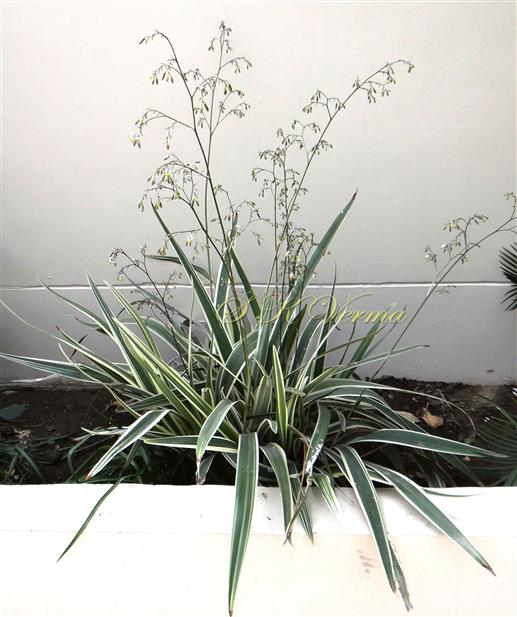
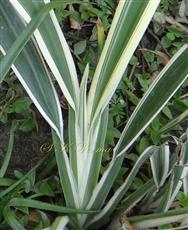
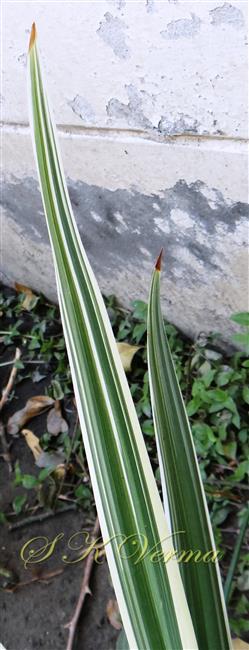
-DSC01198.jpg)

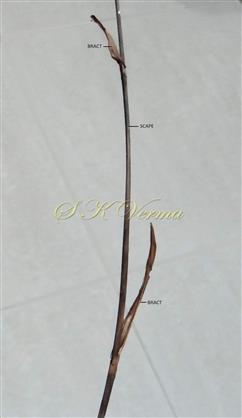
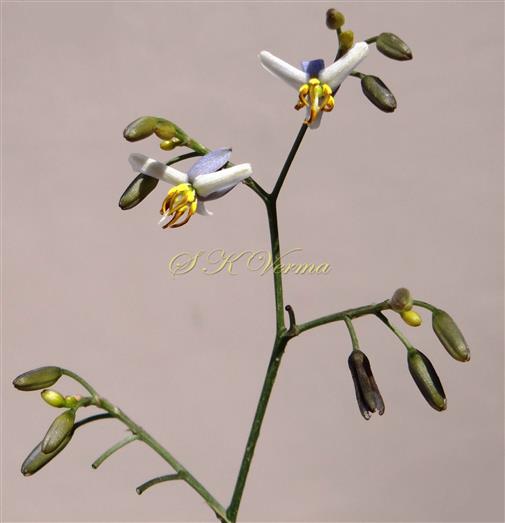
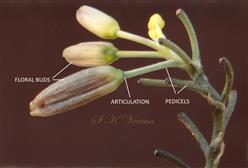
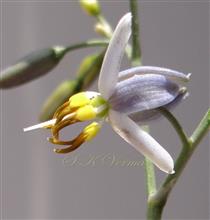
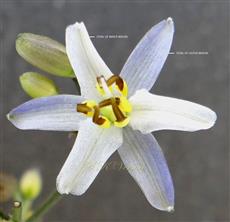
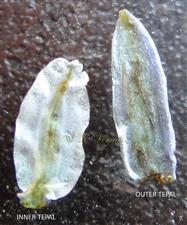






-DSC01198.jpg)
